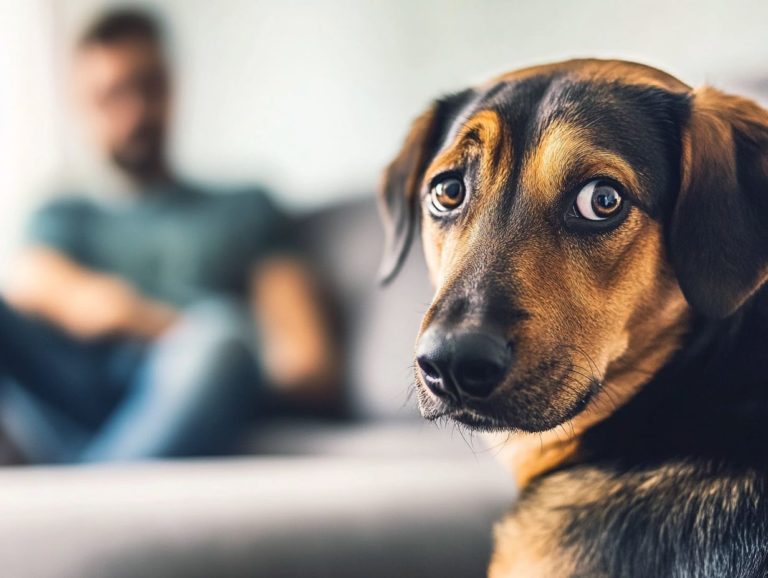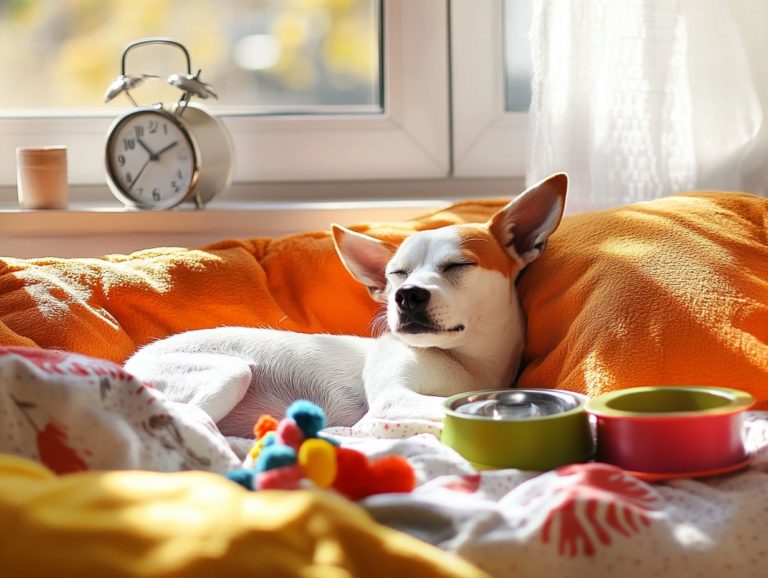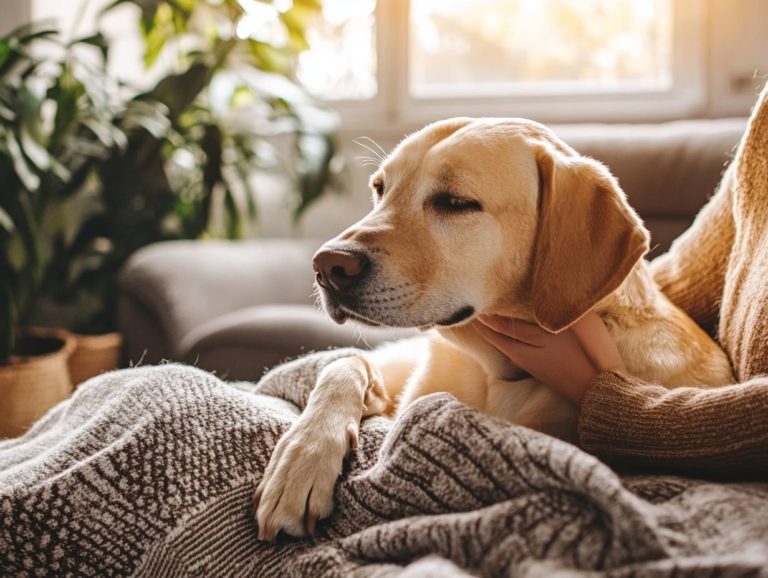5 Natural Ways to Calm an Anxious Pet
Pets, much like people, can experience anxiety, which can manifest in distressful behaviors and disrupt their daily comfort.
Understanding how to soothe your furry friend is essential for their overall well-being.
Get ready to discover five amazing ways to calm your anxious pet! This article delves into natural strategies ranging from incorporating regular exercise to using calming aids and modifying behavior.
It also highlights the signs of anxiety, explores potential causes, and outlines the benefits of natural remedies.
You ll uncover effective strategies to help your pet discover peace and comfort in their life.
Contents
Key Takeaways:
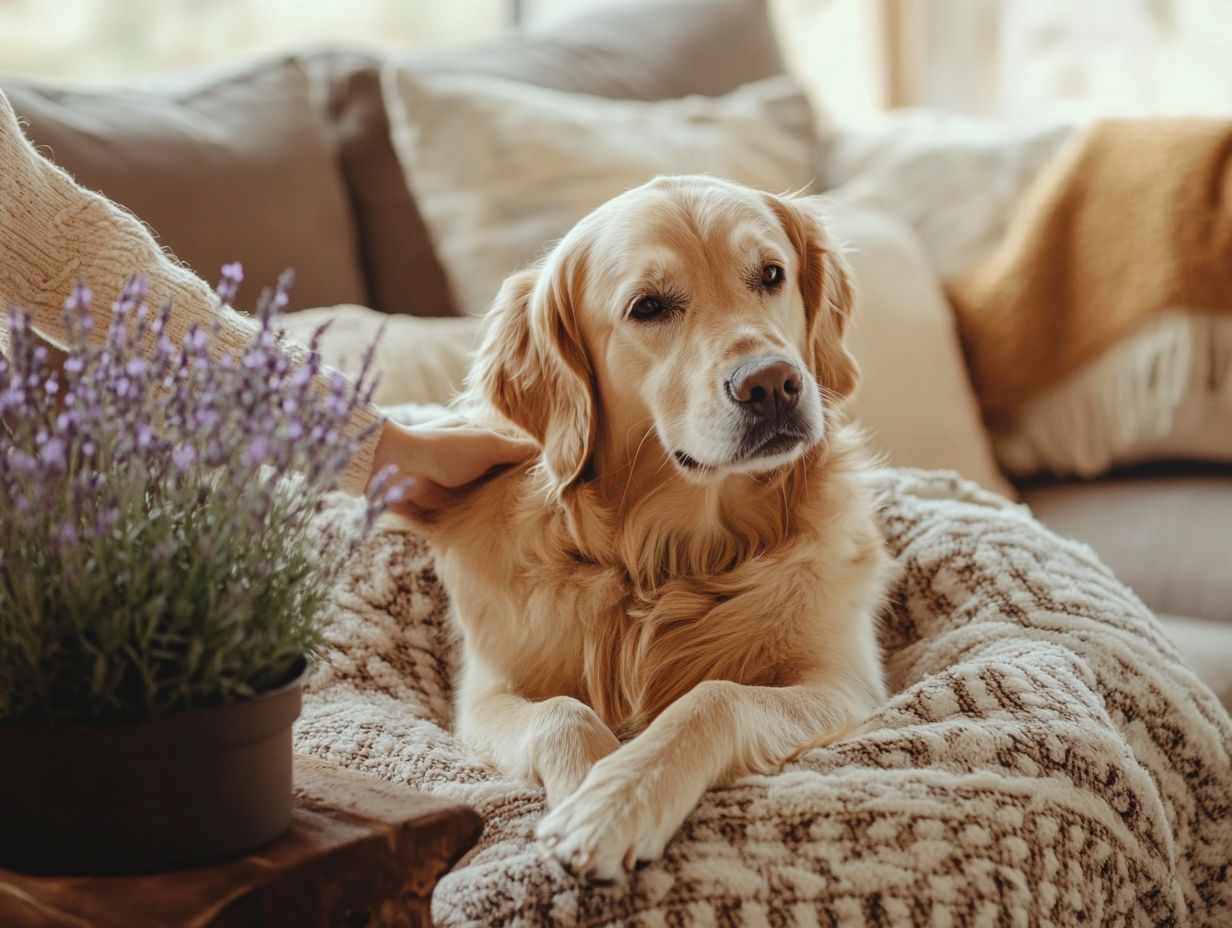
- Regular exercise can help reduce anxiety in pets and improve their overall well-being.
- Using natural calming aids, such as pheromone diffusers or herbal supplements, can help soothe an anxious pet.
- Creating a safe and comfortable environment for your pet, with familiar scents and objects, can help them feel more at ease.
1. Exercise Your Pet Regularly
Regular exercise is essential for maintaining your dog’s mental and physical well-being, especially for those anxious pups that might show stressful behaviors when under-stimulated.
Engaging in daily physical activities not only helps establish a healthy routine but also fosters a deeper understanding between you and your dog.
This ultimately cultivates a more confident and calm atmosphere at home.
To effectively tackle anxiety, you can incorporate a variety of exercises into your dog’s daily schedule.
For instance, taking regular walks at a pace that suits your dog can help release pent-up energy and alleviate stress.
Games of fetch provide bursts of excitement and allow for energy expenditure, while interactive playtime like tug-of-war or agility drills stimulates both their minds and bodies.
Establish a consistent routine that includes these activities.
This promotes physical fitness and reinforces a sense of security, which is beneficial for both puppies and older dogs.
With each session, you ll likely notice improvements in their behavior, leading to a more relaxed and balanced canine companion.
2. Use Calming Aids
Calming aids like Thundershirts, DAP (Dog Appeasing Pheromones), CBD oil, and Rescue Remedy are excellent tools to help alleviate stress and anxiety in dogs.
These aids can make it much easier for your anxious pet to settle down during stressful situations and feel more comfortable in their surroundings, especially when using aromatherapy to calm anxious pets.
Each of these aids works in its own unique way.
For example, Thundershirts apply gentle, constant pressure, mimicking the comforting effects of swaddling.
Dog Appeasing Pheromones release synthetic versions of natural calming pheromones, effectively soothing anxious behaviors.
CBD oil, derived from hemp, is celebrated for its anti-anxiety properties, with various studies supporting its effectiveness.
Meanwhile, Rescue Remedy, a blend of flower essences, is often your go-to for immediate stress relief.
While these aids can be incredibly helpful, it’s crucial to consult with a veterinarian before introducing any new calming measures.
This ensures that the method you choose is safe and suitable for your furry companion.
3. Create a Safe and Comfortable Environment
Creating a safe and comfortable environment for your dog is essential in managing their anxiety.
By establishing an inviting space, you can significantly reduce stress levels, allowing your pet to feel secure and calm key components for reinforcing positive behaviors and ensuring their emotional well-being.
To achieve this, take a moment to assess your home for potential stressors and make the necessary modifications.
A quiet corner with soft bedding, away from the hustle and bustle of daily life, can serve as an ideal retreat for your furry friend.
Be vigilant about your dog s body language; signs like a tucked tail, whining, or excessive panting are often telltale indicators of discomfort or stress.
When you notice these signs, consider adjusting their surroundings by minimizing loud noises, introducing calming scents, or even playing soft music to create a soothing atmosphere.
Such thoughtful modifications are crucial in enhancing your dog’s overall comfort and security.
4. Try Aromatherapy
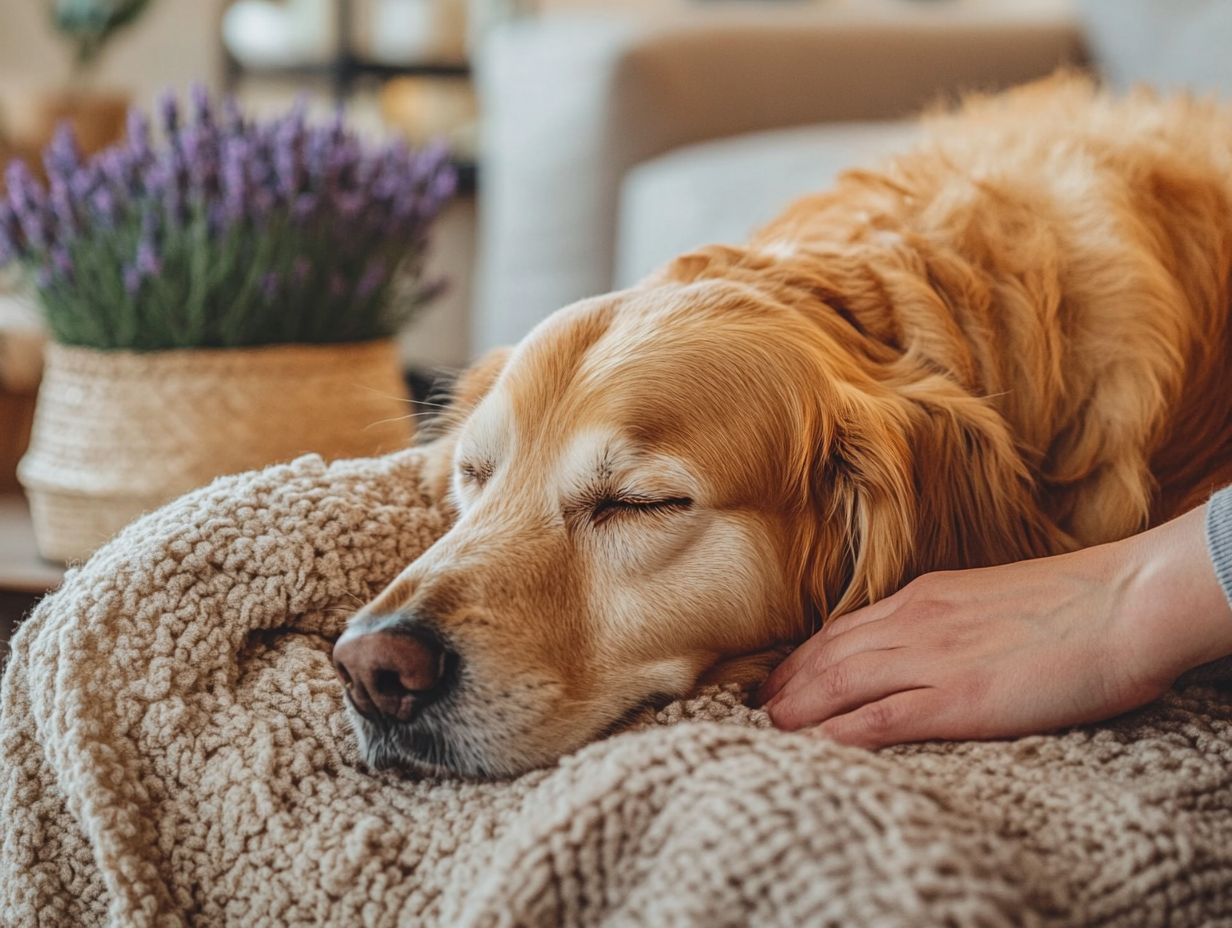
Aromatherapy presents a natural and effective way to support your dog’s emotional well-being. By using soothing smells, you can help reduce anxiety and learn more about how to use calming products for anxious pets.
This creates a serene environment, allowing your furry friend to feel more comfortable.
Essential oils like lavender and chamomile are especially known for their calming properties. Lavender is known to calm both humans and dogs, while chamomile provides an extra layer of tranquility.
When introducing these delightful scents into your dog s life, it’s vital to use safe methods to keep your pet happy and healthy! Diffusers are often the best choice, dispersing the oils gently throughout the space without direct contact.
Always ensure that any oils you use are pure and free from harmful additives to maintain a safe haven for your pet, as not all essential oils are suitable for canine companions.
5. Use Behavior Modification Techniques
Employing behavior modification techniques is essential for managing anxiety in dogs. These approaches help you reinforce positive behaviors and address the underlying signs of stress.
Over time, this leads to a more confident and calm canine companion.
Among the most effective strategies are desensitization and counter-conditioning. Both play crucial roles in your anxious dog s development.
Desensitization involves gradually exposing your dog to the stimuli that trigger their anxiety, allowing them to acclimate at their own pace. For example, if your dog is scared of thunder, play recordings at a low volume while offering treats to create a positive association.
Counter-conditioning complements this by changing your dog s emotional response. Rewarding calm behavior in the presence of the previously feared stimulus helps foster a sense of security.
By integrating these techniques into routine activities, such as walks or playtime, you can create a safe space for your dog. This transforms necessary training into a positive experience rather than a chore.
What Causes Anxiety in Pets?
Understanding what causes anxiety in pets is essential for pet owners seeking effective solutions. Anxiety in dogs can arise from various factors, including separation anxiety, noise phobias, changes in their environment, and even your behavior.
These elements contribute to a heightened state of stress and discomfort for your beloved companions.
Environmental factors often play a significant role in triggering anxiety. Moving to a new home, being exposed to unfamiliar smells or sounds, or the presence of other animals can create a sense of unease.
Behavioral triggers, like a lack of proper socialization or your own anxious demeanor, can further exacerbate these feelings.
Experts note that emotional responses in pets can manifest in various ways, from excessive barking or destructive chewing to withdrawal and excessive grooming.
Consider this: a dog may bark incessantly during thunderstorms, showcasing a noise phobia, while a pet left alone for extended periods might develop separation anxiety. This highlights the complex interplay between different causes of stress in animals, making it crucial for you to be attentive and proactive in addressing their needs.
What Are the Signs of Anxiety in Pets?
Recognizing the signs of anxiety in your pet is essential for providing the support and training they need. Look out for common signs of anxiety in your pet:
- Excessive barking
- Destructive behaviors
- Trembling
- Withdrawal
There are also subtler cues that might escape your notice, such as pacing, a lowered tail, or persistent whining. These behaviors reflect your dog s distress level and can manifest differently based on their unique temperament. For example, if your typically social dog suddenly shies away from visitors, it could be a clear sign of underlying anxiety.
Early intervention is crucial. Addressing these signs promptly can prevent them from escalating into more serious behavioral issues. Techniques like positive reinforcement and creating a calm environment can be highly effective in helping anxious dogs regain their confidence and enhance their overall well-being.
Try these techniques today to help your furry friend feel at ease!
How Can You Determine the Best Calming Aid for Your Pet?
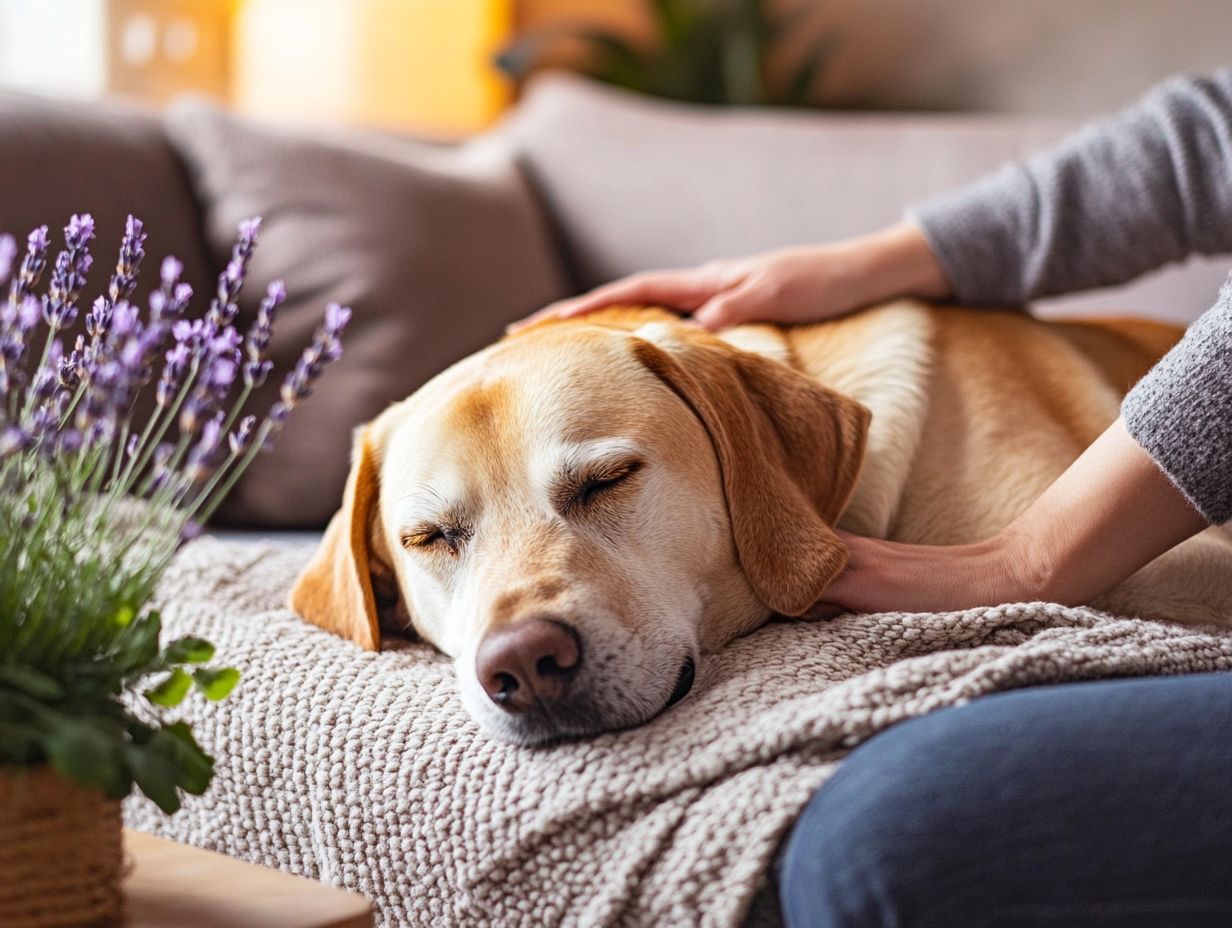
Determining the best calming aid for your pet begins with understanding their specific anxiety triggers. Consulting with veterinarians is essential to explore suitable options, including how to create a calm environment for anxious pets. This ensures that the method you choose effectively addresses your dog’s unique needs and fosters a calm demeanor.
Consider the type of anxiety your dog may be facing whether it s fear of loud noises, separation anxiety, or social discomfort. The age of your dog also plays a significant role in the effectiveness of various aids; younger dogs might respond differently than older ones.
Factor in any existing health conditions, as some products may not be suitable for all pets. Working closely with a veterinarian will help you navigate these options and possibly try several approaches until you find the perfect fit for your furry companion.
What Are the Benefits of Natural Remedies for Pet Anxiety?
Natural remedies can be a game-changer for your pet’s anxiety, often resulting in fewer side effects than traditional medications. Implementing tricks to help anxious pets feel secure can help alleviate stress and foster a calm and supportive environment for anxious dogs, making them appealing for discerning pet owners.
Take aromatherapy, for example. Utilizing essential oils like lavender and chamomile can create a soothing atmosphere in your home. Herbal supplements, such as valerian root and chamomile, are gaining traction too, with research indicating their effectiveness in reducing anxiety levels.
The Thundershirt applies gentle pressure, helping your pet feel secure during stressful moments. Dog Appeasing Pheromone (DAP) products mimic natural scents that dogs produce and have been validated in multiple studies for their ability to diminish anxiety-related behaviors.
Consulting with veterinarians who specialize in holistic approaches can enhance the safety and efficacy of these remedies, ensuring your furry companion receives the best care possible.
Are There Any Risks or Side Effects of Using Natural Remedies for Pet Anxiety?
While natural remedies for pet anxiety are generally safe, it’s essential to be aware of potential risks and side effects. Not all remedies suit every dog, and some may interact poorly with other treatments. For instance, you might consider 5 ways to organize your home for anxious pets. Careful consideration and consultation with your veterinarian are crucial.
Understanding your pet’s specific needs and health conditions is vital before trying any new remedy. For those looking for alternatives, exploring pet-friendly natural remedies for anxiety can be beneficial, as some natural products can trigger allergic reactions or cause unforeseen interactions that might worsen anxiety instead of alleviating it.
Take the time to research the origin and quality of these remedies. They aren’t all created equal or supported by scientific evidence. Consulting with professionals ensures your pet’s safety and equips you with insights into effective treatment options tailored to your companion’s unique behavioral issues.
This proactive approach can lead to better outcomes, resulting in a healthier, happier pet by your side.
How Can You Help Your Pet Overcome Their Anxiety in the Long Term?
Helping your pet overcome anxiety long-term requires a multifaceted approach that combines consistent training, unwavering support, and effective tips for calming an anxious cat tailored to their emotional needs and triggers.
Building this foundation starts with understanding the unique challenges anxious pets face while cultivating a reassuring environment. Employ positive reinforcement training to reward calm behaviors and boost their confidence. Additionally, consider 5 ways to improve your anxious pet’s quality of life through minor adjustments like creating safe spaces or introducing calming scents, which can significantly alleviate anxiety levels.
Incorporating training sessions designed to help with behavior can offer additional coping strategies, ensuring your plan is comprehensive. Maintain patience throughout this journey, regularly reassessing your approaches and celebrating progress, no matter how small. This fosters a sense of security and trust for your beloved companion.
Frequently Asked Questions

What are 5 natural ways to calm an anxious pet?
You can help calm your anxious pet with exercise, scents, herbal remedies, play, and massage.
How does exercise help calm an anxious pet?
Exercise releases natural chemicals in your pet’s brain that make them feel good. This helps reduce anxiety and promotes a relaxed state.
What herbal remedies can calm an anxious pet?
Common options include chamomile, valerian root, and passionflower. These herbs can be found in supplements or teas and have calming effects.
Can scents help calm an anxious pet?
Yes, scents like lavender can soothe pets. Always use pet-safe oils and consult your vet before trying this method.
What is play therapy and how does it help pets?
Play therapy distracts your pet through engaging activities. This can include games, walks, or teaching new tricks.
Is massage therapy effective for anxious pets?
Absolutely! Massage relaxes tight muscles and fosters a sense of calm. It also strengthens the bond between you and your pet.

